Build an SQLite REPL — prompt_toolkit 3.0.50 documentation (original) (raw)
Tutorial: Build an SQLite REPL¶
The aim of this tutorial is to build an interactive command line interface for an SQLite database using prompt_toolkit.
First, install the library using pip, if you haven’t done this already.
pip install prompt_toolkit
Read User Input¶
Let’s start accepting input using theprompt() function. This will ask the user for input, and echo back whatever the user typed. We wrap it in a main()function as a good practice.
from prompt_toolkit import prompt
def main(): text = prompt('> ') print('You entered:', text)
if name == 'main': main()
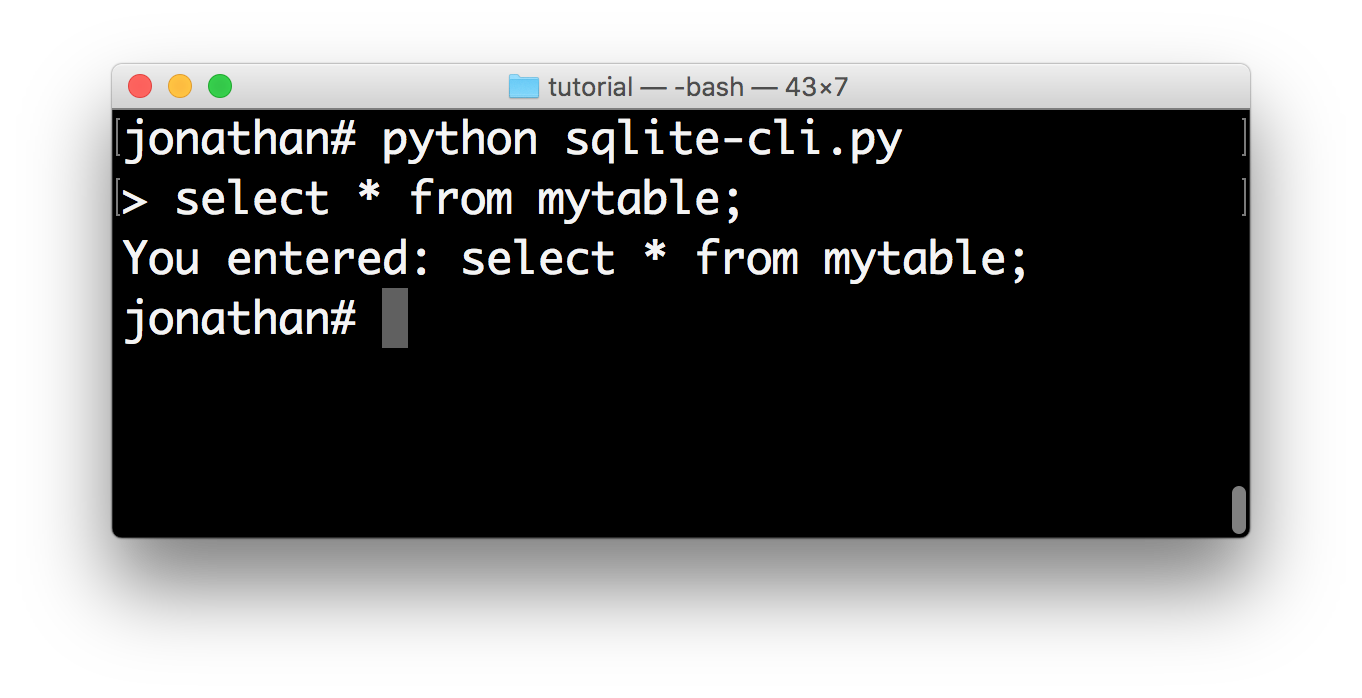
Loop The REPL¶
Now we want to call the prompt()method in a loop. In order to keep the history, the easiest way to do it is to use a PromptSession. This uses anInMemoryHistory underneath that keeps track of the history, so that if the user presses the up-arrow, they’ll see the previous entries.
The prompt() method raisesKeyboardInterrupt when ControlC has been pressed and EOFError when ControlD has been pressed. This is what people use for cancelling commands and exiting in a REPL. The try/except below handles these error conditions and make sure that we go to the next iteration of the loop or quit the loop respectively.
from prompt_toolkit import PromptSession
def main(): session = PromptSession()
while True:
try:
text = session.prompt('> ')
except KeyboardInterrupt:
continue
except EOFError:
break
else:
print('You entered:', text)
print('GoodBye!')if name == 'main': main()
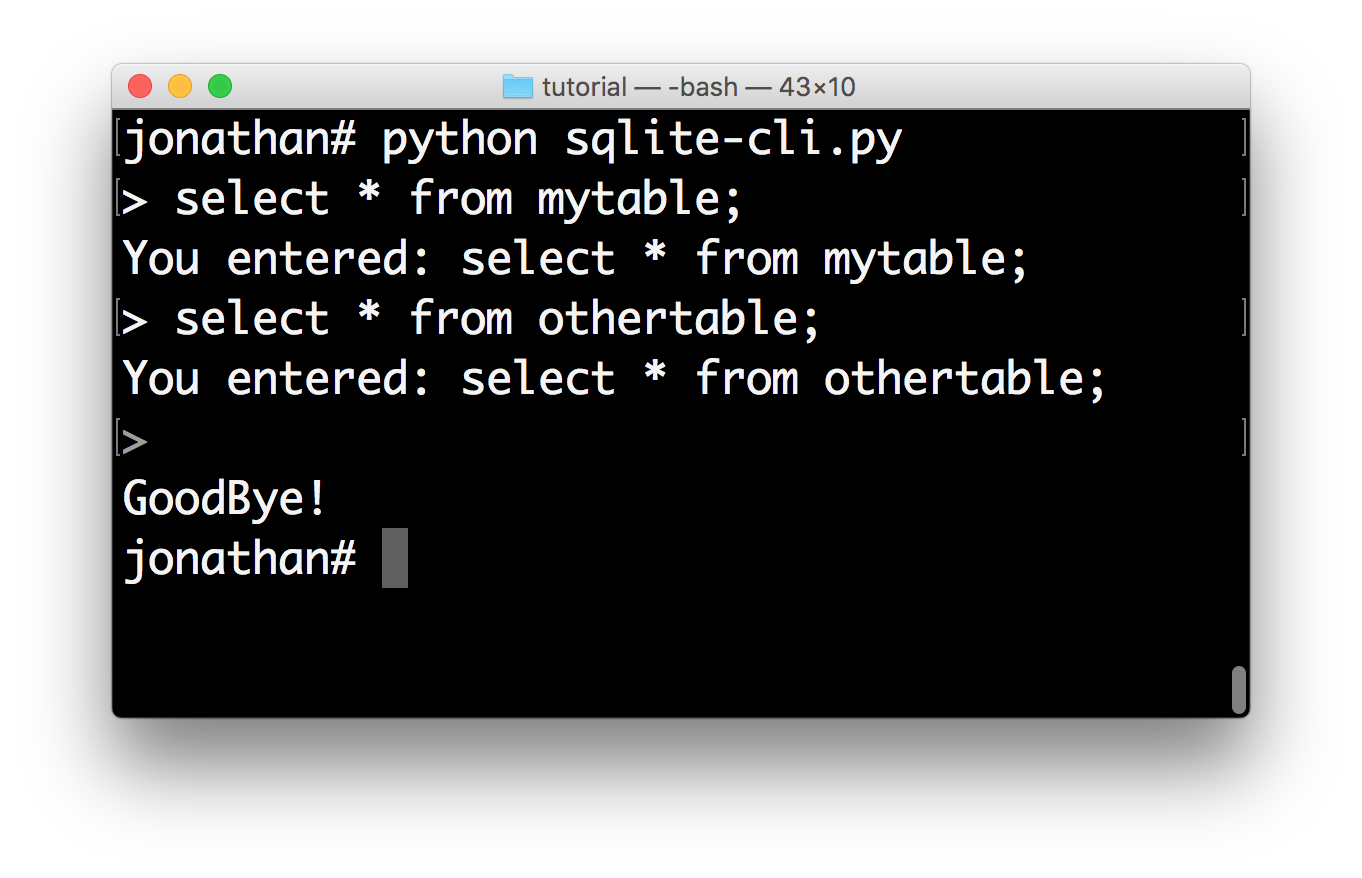
Syntax Highlighting¶
This is where things get really interesting. Let’s step it up a notch by adding syntax highlighting to the user input. We know that users will be entering SQL statements, so we can leverage the Pygments library for coloring the input. The lexer parameter allows us to set the syntax lexer. We’re going to use the SqlLexer from the Pygments library for highlighting.
Notice that in order to pass a Pygments lexer to prompt_toolkit, it needs to be wrapped into a PygmentsLexer.
from prompt_toolkit import PromptSession from prompt_toolkit.lexers import PygmentsLexer from pygments.lexers.sql import SqlLexer
def main(): session = PromptSession(lexer=PygmentsLexer(SqlLexer))
while True:
try:
text = session.prompt('> ')
except KeyboardInterrupt:
continue
except EOFError:
break
else:
print('You entered:', text)
print('GoodBye!')if name == 'main': main()
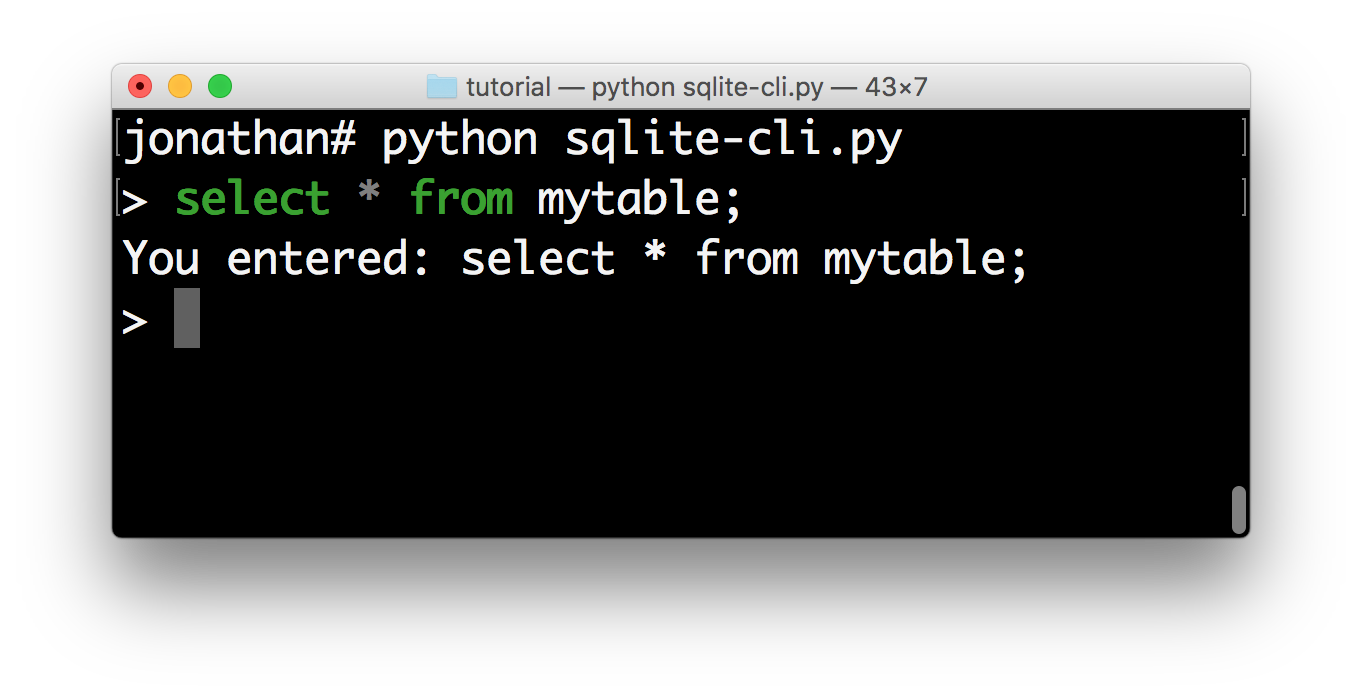
Auto-completion¶
Now we are going to add auto completion. We’d like to display a drop down menu of possible keywords when the user starts typing.
We can do this by creating an sql_completer object from theWordCompleter class, defining a set ofkeywords for the auto-completion.
Like the lexer, this sql_completer instance can be passed to either thePromptSession class or theprompt() method.
from prompt_toolkit import PromptSession from prompt_toolkit.completion import WordCompleter from prompt_toolkit.lexers import PygmentsLexer from pygments.lexers.sql import SqlLexer
sql_completer = WordCompleter([ 'abort', 'action', 'add', 'after', 'all', 'alter', 'analyze', 'and', 'as', 'asc', 'attach', 'autoincrement', 'before', 'begin', 'between', 'by', 'cascade', 'case', 'cast', 'check', 'collate', 'column', 'commit', 'conflict', 'constraint', 'create', 'cross', 'current_date', 'current_time', 'current_timestamp', 'database', 'default', 'deferrable', 'deferred', 'delete', 'desc', 'detach', 'distinct', 'drop', 'each', 'else', 'end', 'escape', 'except', 'exclusive', 'exists', 'explain', 'fail', 'for', 'foreign', 'from', 'full', 'glob', 'group', 'having', 'if', 'ignore', 'immediate', 'in', 'index', 'indexed', 'initially', 'inner', 'insert', 'instead', 'intersect', 'into', 'is', 'isnull', 'join', 'key', 'left', 'like', 'limit', 'match', 'natural', 'no', 'not', 'notnull', 'null', 'of', 'offset', 'on', 'or', 'order', 'outer', 'plan', 'pragma', 'primary', 'query', 'raise', 'recursive', 'references', 'regexp', 'reindex', 'release', 'rename', 'replace', 'restrict', 'right', 'rollback', 'row', 'savepoint', 'select', 'set', 'table', 'temp', 'temporary', 'then', 'to', 'transaction', 'trigger', 'union', 'unique', 'update', 'using', 'vacuum', 'values', 'view', 'virtual', 'when', 'where', 'with', 'without'], ignore_case=True)
def main(): session = PromptSession( lexer=PygmentsLexer(SqlLexer), completer=sql_completer)
while True:
try:
text = session.prompt('> ')
except KeyboardInterrupt:
continue
except EOFError:
break
else:
print('You entered:', text)
print('GoodBye!')if name == 'main': main()
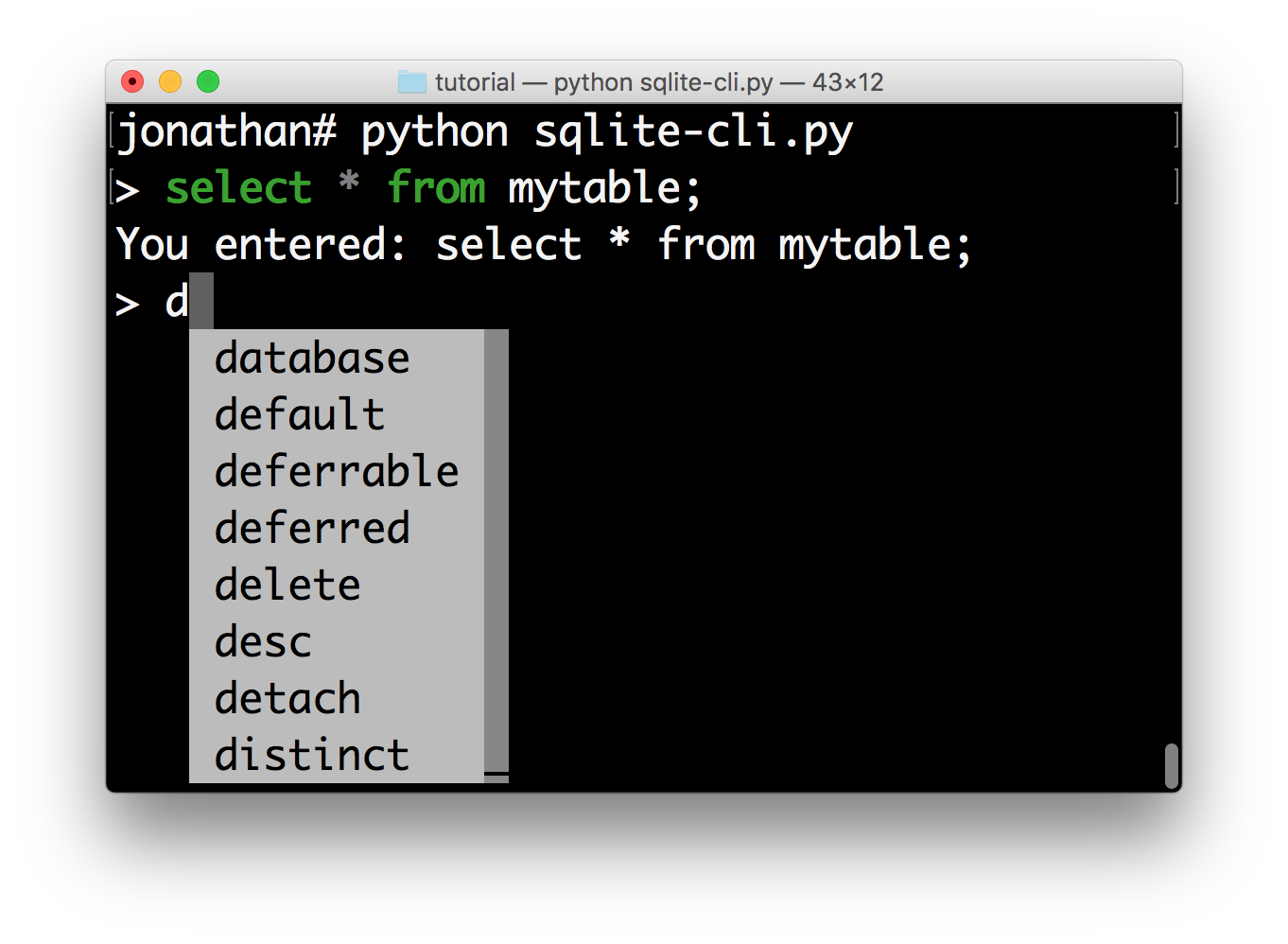
In about 30 lines of code we got ourselves an auto completing, syntax highlighting REPL. Let’s make it even better.
Hook up Sqlite¶
This step is the final step to make the SQLite REPL actually work. It’s time to relay the input to SQLite.
Obviously I haven’t done the due diligence to deal with the errors. But it gives a good idea of how to get started.
#!/usr/bin/env python import sys import sqlite3
from prompt_toolkit import PromptSession from prompt_toolkit.completion import WordCompleter from prompt_toolkit.lexers import PygmentsLexer from prompt_toolkit.styles import Style from pygments.lexers.sql import SqlLexer
sql_completer = WordCompleter([ 'abort', 'action', 'add', 'after', 'all', 'alter', 'analyze', 'and', 'as', 'asc', 'attach', 'autoincrement', 'before', 'begin', 'between', 'by', 'cascade', 'case', 'cast', 'check', 'collate', 'column', 'commit', 'conflict', 'constraint', 'create', 'cross', 'current_date', 'current_time', 'current_timestamp', 'database', 'default', 'deferrable', 'deferred', 'delete', 'desc', 'detach', 'distinct', 'drop', 'each', 'else', 'end', 'escape', 'except', 'exclusive', 'exists', 'explain', 'fail', 'for', 'foreign', 'from', 'full', 'glob', 'group', 'having', 'if', 'ignore', 'immediate', 'in', 'index', 'indexed', 'initially', 'inner', 'insert', 'instead', 'intersect', 'into', 'is', 'isnull', 'join', 'key', 'left', 'like', 'limit', 'match', 'natural', 'no', 'not', 'notnull', 'null', 'of', 'offset', 'on', 'or', 'order', 'outer', 'plan', 'pragma', 'primary', 'query', 'raise', 'recursive', 'references', 'regexp', 'reindex', 'release', 'rename', 'replace', 'restrict', 'right', 'rollback', 'row', 'savepoint', 'select', 'set', 'table', 'temp', 'temporary', 'then', 'to', 'transaction', 'trigger', 'union', 'unique', 'update', 'using', 'vacuum', 'values', 'view', 'virtual', 'when', 'where', 'with', 'without'], ignore_case=True)
style = Style.from_dict({ 'completion-menu.completion': 'bg:#008888 #ffffff', 'completion-menu.completion.current': 'bg:#00aaaa #000000', 'scrollbar.background': 'bg:#88aaaa', 'scrollbar.button': 'bg:#222222', })
def main(database): connection = sqlite3.connect(database) session = PromptSession( lexer=PygmentsLexer(SqlLexer), completer=sql_completer, style=style)
while True:
try:
text = session.prompt('> ')
except KeyboardInterrupt:
continue # Control-C pressed. Try again.
except EOFError:
break # Control-D pressed.
with connection:
try:
messages = connection.execute(text)
except Exception as e:
print(repr(e))
else:
for message in messages:
print(message)
print('GoodBye!')if name == 'main': if len(sys.argv) < 2: db = ':memory:' else: db = sys.argv[1]
main(db)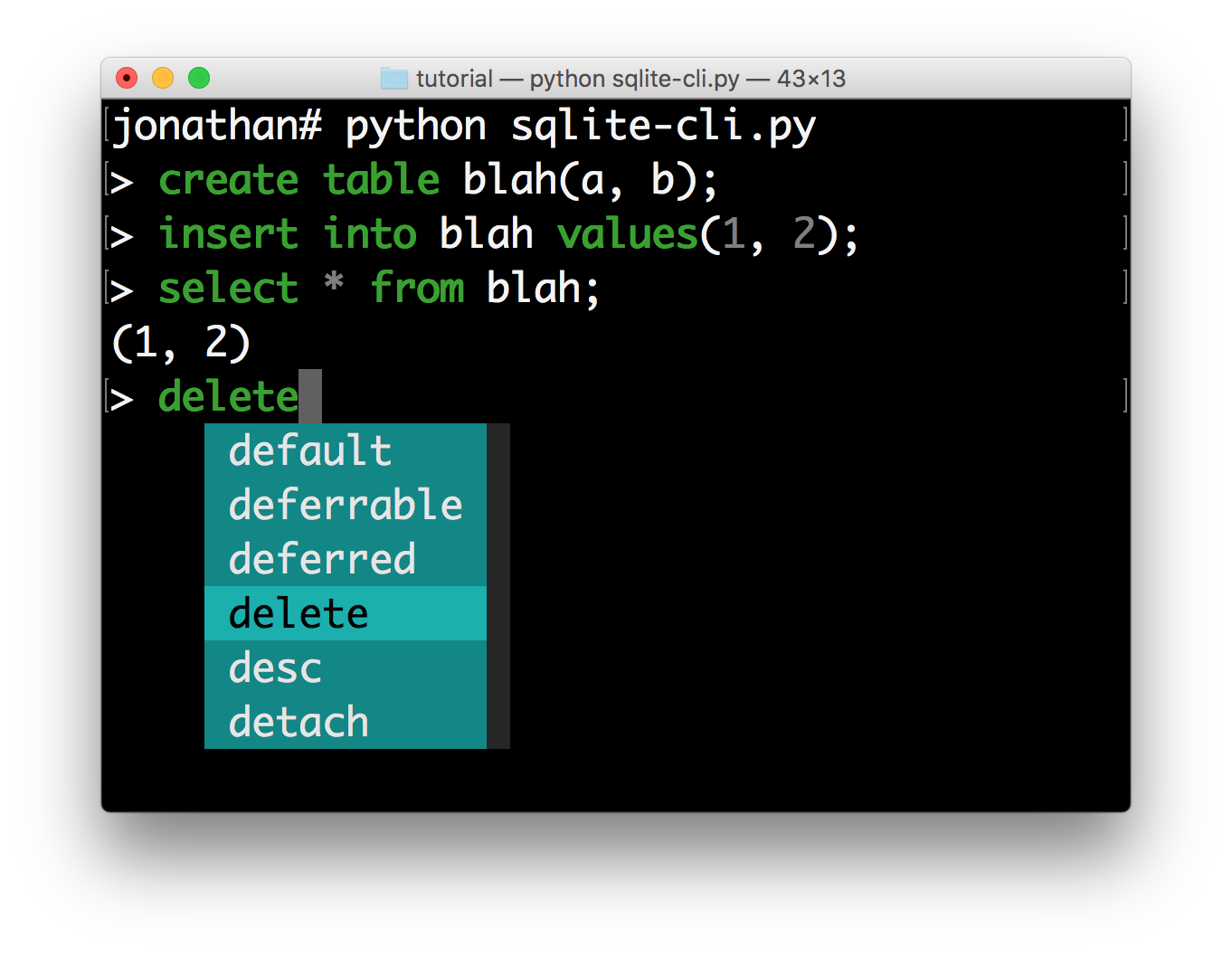
I hope that gives an idea of how to get started on building command line interfaces.
The End.